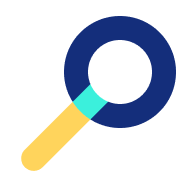 Getting started
Getting started
 Exploring and using data
Exploring and using data
Exploring catalogs and datasets
Exploring a catalog of datasets
What's in a dataset
Filtering data within a dataset
An introduction to the Explore API
An introduction to the Automation API
Introduction to the WFS API
Downloading a dataset
Creating maps and charts
Creating advanced charts with the Charts tool
Overview of the Maps interface
Configure your map
Manage your maps
Reorder and group layers in a map
Creating multi-layer maps
Share your map
Navigating maps made with the Maps interface
Rename and save a map
Creating pages with the Code editor
How to limit who can see your visualizations
Archiving a page
Managing a page's security
Creating a page with the Code editor
Content pages: ideas, tips & resources
How to insert internal links on a page or create a table of contents
Sharing and embedding a content page
How to troubleshoot maps that are not loading correctly
Creating content with Studio
Creating content with Studio
Adding a page
Publishing a page
Editing the page layout
Configuring blocks
Previewing a page
Adding text
Adding a chart
Adding an image block to a Studio page
Adding a choropleth map block in Studio
Adding a points of interest map block in Studio
Adding a key performance indicator (KPI)
Configuring page information
Using filters to enhance your pages
Refining data
Managing page access
How to edit the url of a Studio page
Adding a map block in Studio
Visualizations
Managing saved visualizations
Configuring the calendar visualization
The basics of dataset visualizations
Configuring the images visualization
Configuring the custom view
Configuring the table visualization
Configuring the map visualization
Understanding automatic clustering in maps
Configuring the analyze visualization
 Publishing data
Publishing data
Publishing datasets
Creating a dataset
Creating a dataset from a local file
Creating a dataset with multiple files
Creating a dataset from a remote source (URL, API, FTP)
Creating a dataset using dedicated connectors
Creating a dataset with media files
Federating an Opendatasoft dataset
Publishing a dataset
Publishing data from a CSV file
Publishing data in JSON format
Supported file formats
Promote mobility data thanks to GTFS and other formats
Configuring datasets
Automated removal of records
Configuring dataset export
Checking dataset history
Configuring the tooltip
Dataset actions and statuses
Dataset limits
Defining a dataset schema
How Opendatasoft manages dates
How and where Opendatasoft handles timezones
How to find your workspace's IP address
Keeping data up to date
Processing data
Translating a dataset
How to configure an HTTP connection to the France Travail API
Deciding what license is best for your dataset
Types of source files
OpenStreetMap files
Shapefiles
JSON files
XML files
Spreadsheet files
RDF files
CSV files
MapInfo files
GeoJSON files
KML/KMZ files
GeoPackage
Connectors
Saving and sharing connections
Airtable connector
Amazon S3 connector
ArcGIS connector
Azure Blob storage connector
Database connector
Dataset of datasets (workspace) connector
Eco Counter connector
Feed connector
Google BigQuery connector
Google Drive connector
How to find the Open Agenda API Key and the Open Agenda URL
JCDecaux connector
Netatmo connector
OpenAgenda connector
Realtime connector
Salesforce connector
SharePoint connector
U.S. Census connector
WFS connector
Databricks connector
Harvesters
Harvesting a catalog
ArcGIS harvester
ArcGIS Hub Portals harvester
CKAN harvester
CSW harvester
FTP with meta CSV harvester
Opendatasoft Federation harvester
Quandl harvester
Socrata harvester
data.gouv.fr harvester
data.json harvester
Processors
What is a processor and how to use one
Add a field processor
Compute geo distance processor
Concatenate text processor
Convert degrees processor
Copy a field processor
Correct geo shape processor
Create geo point processor
Decode HTML entities processor
Decode a Google polyline processor
Deduplicate multivalued fields processor
Delete record processor
Expand JSON array processor
Expand multivalued field processor
Expression processor
Extract HTML processor
Extract URLs processor
Extract bit range processor
Extract from JSON processor
Extract text processor
File processor
GeoHash to GeoJSON processor
GeoJoin processor
Geocode with ArcGIS processor
Geocode with BAN processor (France)
Geocode with PDOK processor
Geocode with the Census Bureau processor (United States)
Geomasking processor
Get coordinates from a three-word address processor
IP address to geo Coordinates processor
JSON array to multivalued processor
Join datasets processor
Meta expression processor
Nominatim geocoder processor
Normalize Projection Reference processor
Normalize URL processor
Normalize Unicode values processor
Normalize date processor
Polygon filtering processor
Replace text processor
Replace via regular expression processor
Retrieve Administrative Divisions processor
Set timezone processor
Simplify Geo Shape processor
Skip records processor
Split text processor
Transform boolean columns to multivalued field processor
Transpose columns to rows processor
WKT and WKB to GeoJson processor
what3words processor
Data Collection Form
About the Data Collection Form feature
Data Collection Forms associated with your Opendatasoft workspace
Create and manage your data collection forms
Sharing and moderating your data collection forms
Dataset metadata
Analyzing how your data is used
Getting involved: Sharing, Reusing and Reacting
Discovering & submitting data reuses
Sharing through social networks
Commenting via Disqus
Submitting feedback
Following dataset updates
Sharing and embedding data visualizations
Monitoring usage
An overview of monitoring your workspaces
Analyzing user activity
Analyzing actions
Detail about specific fields in the ods-api-monitoring dataset
How to count a dataset's downloads over a specific period
Analyzing data usage
Analyzing a single dataset with its monitoring dashboard
Analyzing back office activity
Using the data lineage feature
 Managing your users
Managing your users
Managing limits
Managing users
Managing users
Setting quotas for individual users
Managing access requests
Inviting users to the portal
Managing workspaces
 Managing your portal
Managing your portal
Configuring your portal
Configure catalog and dataset pages
Configuring a shared catalog
Sharing, reusing, communicating
Customizing your workspace's URL
Managing legal information
Connect Google Analytics (GA4)
Regional settings
Pictograms reference
Managing tracking
Look & Feel
Branding your portal
Customizing portal themes
How to customize my portal according to the current language
Managing the dataset themes
Configuring data visualizations
Configuring the navigation
Adding IGN basemaps
Adding assets
Plans and quotas
Managing security
Configuring your portal's overall security policies
A dataset's Security tab
Mapping your directory to groups in Opendatasoft (with SSO)
Single sign-on with OpenID Connect
Single sign-on with SAML
Parameters
- Home
- Publishing data
- Configuring datasets
- Deciding what license is best for your dataset
Deciding what license is best for your dataset
Updated
by Nicolas Terpolilli
This page provides guidance on how to select an appropriate license for a dataset. Choosing the right license for your dataset is crucial to establish the terms under which others can use, modify, and distribute your data. This guide outlines key considerations and popular licensing options for open datasets.
Open data or private, your users need to know what they can do with the data you've provided. License metadata allows you to inform users of the precise conditions for your data's reuse, and that you can also share in the dataset's description.
Considerations when choosing a license
- Intended use: Decide how you want others to use your dataset. Will it be for research, commercial purposes, educational use, or a combination of these uses? The license should reflect how you want the data to be used.
- Openness: Decide on the level of openness you want to provide. Some licenses require derivative works to be released under the same terms, while others allow more flexibility. Consider the balance between openness and potential restrictions.
- Attribution: Decide whether you want users to give you credit when they use your dataset. Some licenses require attribution, while others do not. This can affect how your dataset is acknowledged in downstream projects.
- Modification: Determine whether you want others to be able to modify your dataset. If yes, specify whether modified versions must be shared under the same license.
- Distribution: Consider whether you want to allow commercial distribution of your dataset. Some licenses prohibit commercial use, while others allow it.
- Compatibility: If your dataset builds on or incorporates other open datasets, ensure that the license you choose is compatible with those licenses to avoid conflicts.
You must anonymize personal information before any distribution, in a restricted ecosystem or not. Refer to the General Data Protection Regulation (GDPR) and contact your Data Protection Officer (DPO) if necessary.
Popular licensing options
1. Open data licenses
Open data licenses are specifically designed for open data. They provide legal tools to share and use data openly while addressing common issues.
For this you can use:
- The Etalab Open License: it authorizes the reproduction, redistribution, adaptation and commercial exploitation of data, on the sole condition of mentioning paternity.
- The Open Data Commons Open Database License (ODbL): it allows you to freely share the dataset, to use it to create services and to modify it, on condition that you name its creator, keep it open and redistribute it under the same conditions and under the same license.
2. Creative Commons licenses
Creative Commons licenses provide a range of options that allow creators to retain certain rights while granting specific permissions to others. These licenses are well-suited to datasets that require different levels of openness.
- CC0 : this is the most permissive because it puts the dataset in the public domain, without any restriction on reuse.
- CC BY (Attribution): Requires attribution. Others can use, modify, and distribute your dataset, even for commercial purposes, as long as they credit you.
- CC BY-SA (Attribution-ShareAlike): Requires attribution and any derivative works to be shared under the same license. This encourages a "viral" open approach.
- CC BY-NC (Attribution-NonCommercial): Allows others to use and modify your dataset but not for commercial purposes.
3. Public domain dedication
You can choose to release your dataset into the public domain, waiving all rights. This allows anyone to use the dataset for any purpose without restrictions.
4. Custom license
You can create a custom license that suits your specific requirements. Ensure that the terms are clear and easily understandable.
Conclusion
Selecting the right license for your open dataset involves a careful assessment of your goals and values. By considering the intended use, openness, attribution, modification, distribution, compatibility, and available licensing options, you can make an informed decision that promotes the effective use and sharing of your dataset.
